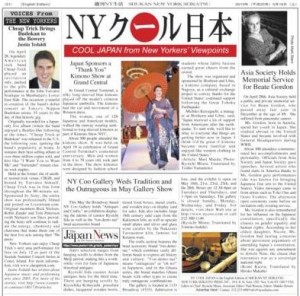Justin’s Japan: Japan Society Serves Up Summer Film Festival
By JQ magazine editor Justin Tedaldi (CIR Kobe-shi, 2001-02) for Shukan NY Seikatsu. Visit his Examiner.com Japanese culture page here for related stories.
Summer’s here, and that means a new season of JAPAN CUTS: The New York Festival of Contemporary Japanese Cinema, running at Japan Society from July 11-21.
Now in its seventh year, JAPAN CUTS offers 25 titles, all of which are a mix of New York, U.S. and International premieres. Highlights include the smash-hit samurai blockbuster Rurouni Kenshin, the multi-Japan Academy Prize-winning The Kirishima Thing, and the latest horror film from Takashi Miike, Lesson of the Evil.
“In contrast with the past few years, the selection of titles for JAPAN CUTS is much leaner, and more focused on art house productions and film oddities, though there is still a number of ‘mainstream’ crowd-pleasers in the lineup,” says Japan Society’s chief film programmer Samuel Jamier. “Rather than a ‘best-of’ list, this year’s crop brings a block of dark matter, and provides an unblinking look at the dark side of Japan.”
Co-presented with the New York Asian Film Festival (which itself is now in its 12th year), JAPAN CUTS has attracted over 30,000 filmgoers and presented over 150 feature films—many never before seen in the U.S.—as well as a number of panels, post-screening parties, and exclusive Q&As with filmmakers and actors. Past guests have included Koji Yakusho, Masami Nagasawa, and Sora Aoi.
For a complete listing of films and appearances, visit www.japansociety.org/japan-cuts-2013.
Job: SNYS Editor (NYC)
Thanks to JET alum Paul Benson for sharing this jet-relevant job listing. Posted by Kim ‘Kay’ Monroe (Miyazaki-shi, 1995 -97). Click here to join the JETwit Jobs Google Group and receive job listings even sooner by email.
————————————————————————————————————
Position: SNYS English Page Editor
Posted by: Shukan NY Seikatsu (週刊NY生活)
Type: N/A
Location: New York City
Salary: See below
Start Date: N/A
Overview:
JET alum freelance translator and journalist Paul Benson is seeking a replacement for himself at Shukan New York Seikatsu as he prepares to move on to grad school.
New York Seikatsu Press is looking for an English page editor. The Shukan NY Seikatsu (週刊NY生活) paper has broad readership in the United States and Japan. This position is ideal for someone interested in journalism, editing, and Japanese-English translation. The applicant must be able to commute into New York City once per week.
* Prior professional translation and journalism experience is recommended, but not required. Read More
JQ Magazine: Book Review – ‘From Postwar to Postmodern, Art in Japan 1945-1989: Primary Documents’
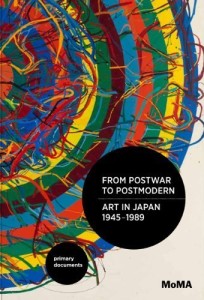
“What emerges from the multitude of ideas here is that art in Japan from this period is a visual record of repercussions that are still being felt today.” (Duke University Press)
By Jessica Sattell (Fukuoka-ken, 2007-08) for JQ magazine. Jessica is a freelance writer and a graduate student in arts journalism. She was previously the publicist for Japan-focused publishers Stone Bridge Press and Chin Music Press.
The abstract and avant-garde sculptor, painter and all-around revolutionary Japanese artist Tarō Okamoto famously said, “Art is an explostion” (geijutsu wa bakuhatsu da).
“Explosive” barely describes the energy and innovation in Japanese art in the latter half of the twentieth century. As From Postwar to Postmodern, Art in Japan 1945-1989: Primary Documents discusses, the decades between the end of World War II and the end of the Cold War marked an intensely fruitful period of groundbreaking creativity in Japan. The excitement, anxiety, and electricity that surged against the rigidity of old structures propelled Japanese art and artists into a much greater international conversation.
Published earlier this year by the Museum of Modern Art in New York and distributed by Duke University Press, this hefty tome accompanied the fall 2012-winter 2013 MoMA exhibition Tokyo 1955-1970: A New Avant Garde. There’s been a huge wave of both popular and scholarly interest in Japanese modern and contemporary art and dozens of high-profile shows at major North American museums and galleries, but the MoMA exhibit was the first to examine the “postwar” period that had been previously underrepresented. Part of this may be that the term “postwar” is tricky to define; the effects of WWII are undoubtedly still felt today and many argue that Japan is still “postwar.”
This book provides a solid foundation for an exploration of the issues and precedents leading up to the transformation of “postwar” art into the “postmodern” time. But, rather than simply rehash existing scholarship about Japanese history from 1945-1989, the book’s co-editors allow the artists, philosophers, critics and curators of this historical time to speak for themselves. The bulk of From Postwar to Postmodern includes a huge and multifaceted collection of primary source materials—personal essays, artist statements, interviews, magazine articles, interviews, critiques and manifestos—many of which have been translated into English for the very first time.
Justin’s Japan: Nippon in New York — JAPAN CUTS, Lincoln Center and Aerosmith Rock the Rising Sun
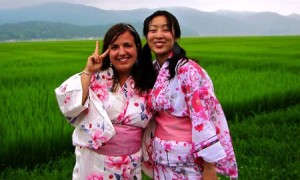
Live Your Dream: The Taylor Anderson Story premieres at Japan Society in New York July 16 as part of their annual JAPAN CUTS summer film festival. (© 2012 Global Film Network. All rights reserved.)
By JQ magazine editor Justin Tedaldi (CIR Kobe-shi, 2001-02) for Examiner.com. Visit his Japanese culture page here for related stories.
After you’ve seen the outdoor fireworks, enjoy some summer events in the cool indoors, whether it’s catching one of 20 films in Japan Society‘s annual festival or firing up the newest home video release from Aerosmith that documents the band’s triumphant return to Japan following the 2011 Tohoku earthquake and tsunami.
This month’s highlights include:
July 11-21
Japan Society, 333 East 47th Street
$12 general/$9 Japan Society members, seniors and students. I’M FLASH! prices $15 general/$12 Japan Society members
Now in its seventh season, with 10 days of screenings and over 20 titles, JAPAN CUTS 2013 presents the roughest, sharpest, and smoothest of today’s cutting-edge Japanese film scene, encompassing bigger-than-life blockbusters, high-concept art house titles, moving and provoking documentaries, delirious rom-coms, refined melodramas and a handful of UFOs—unidentified film objects. Dovetailing with the New York Asian Film Festival, this year’s highlights include the smash-hit samurai blockbuster Rurouni Kenshin; Eiki Takahashi’s absorbing glimpse into the glitzy world of Japanese pop music, DOCUMENTARY OF AKB48: Show Must Go On; the winner of the 36th Japan Academy Prize for Best Picture and Best Director, The Kirishima Thing; plus the new film from the wildly prolific auteur Takashi Miike, the psycho killer-teacher horror film Lesson of the Evil, a return to the director’s signature gonzo schlockmeister approach.
July 18-20
Lincoln Center Festival presents Matsukaze
Gerald W. Lynch Theater, 524 West 59th Street
$35-$75
Harmonious sounds and haunting songs converge in this exquisite production of Matsukaze (Japanese for “wind in the pines”). Inspired by a popular 15th-century play crafted in part by Noh master Zeami, the opera features a spare, ethereal score by Toshio Hosokawa, one of Japan’s most prominent living composers of contemporary classical music. Matsukaze tells the story of two sisters, two lingering spirits, who wander the porous boundary of the living and the dead in hopes of being freed from a former mortal lover. John Kennedy conducts the Talea Ensemble and a cast of soloists and chorus in this arresting, dreamlike performance set in the shadowy place where the wall between the ephemeral and the corporeal disappears. Sung in German with English supertitles.
For the complete story, click here.
JQ Magazine: Film Review – JAPAN CUTS 2013 at Japan Society
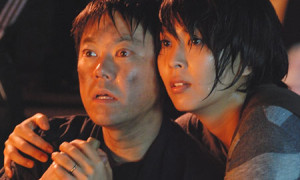
Dreams for Sale premieres July 13 at Japan Society in New York as part of their annual JAPAN CUTS film festival. (© 2012 Dreams for Sale Film Partners)
By Lyle Sylvander (Yokohama-shi, 2001-02) for JQ magazine. Lyle is entering a master’s program at the School of International and Public Affairs at Columbia University (MIA 2013) and has been writing for the JET Alumni Association since 2004. He is also the goalkeeper for FC Japan, a New York City-based soccer team.
Now in its seventh season, the JAPAN CUTS 2013 film festival runs from July 11-21 at Japan Society in New York and features less mainstream and more art house fare than in festivals past. JQ was able to screen three films from this year’s festival: Dreams for Sale (Yume Uru Futari), Helter Skelter (Heruta Sukeruta) and A Story of Yonosuke (Yokomichi Yonosuke).
Dreams for Sale, the most affecting of the three, tells the story of a young couple, Kanya (Sadao Abe) and Satoko (Takako Matsu), who find themselves in dire straits when their restaurant burns down to the ground. They soon realize, however, that the situation allows them to seek sympathy and romance money out of lonely singles that they encounter. This morality tale is directed in a naturalistic style by Miwa Nishiwaka. Within the director’s moving frame, the two main protagonists are allowed to express themselves both fully and in nuance as they work in tandem to bilk yen out of the unsuspecting victims.
What makes the film work so well is Nishikawa’s matter-of-fact stylistic depiction; she simply allows events to unfold naturally as the camera unobtrusively records them. At first, Kanya and Satoko’s cynical schemes have a darkly comic undertone, but gradually we, as the audience, begin to see the subtle changes that the couple undergoes as they begin to first doubt the morality of what they are doing and then doubt the strength of their own marriage and relationship. As in many great tragedies, this inner turmoil spills out into the external world as their actions have unpredictable repercussions beyond their control and affect unintended innocent victims.
Justin’s Japan: Cheap Trick Brings Budokan to the Bowery
By JQ magazine editor Justin Tedaldi (CIR Kobe-shi, 2001-02) for Shukan NY Seikatsu. Visit his Examiner.com Japanese culture page here for related stories.
On April 28, legendary American rockers Cheap Trick played an invitation only, packed to the gills performance at the John Varvatos boutique in Manhattan’s Lower East Side. The occasion: a tuneful recreation of the band’s debut concert at Tokyo’s Nippon Budokan arena, 35 years to the day of that historic gig.
Originally recorded for a Japan-only live album (where the band enjoyed a Beatles-like following at the time), Cheap Trick at Budokan was released in the U.S. the following year, igniting the band’s popularity at home. It remains their best-selling album at over three million copies sold, and hits like “I Want You to Want Me” and “Surrender” remain classic rock staples.
Held at the former site of another storied rock venue, CBGB, and hosted by Varvatos himself, Cheap Trick was in fine form throughout the 90-minute set. Sponsored by Sony, the entire show was professionally filmed and posted on Livestream.com. Original members Rick Nielsen, Robin Zander and Tom Petersson (with Nielsen’s son Daxx providing the beat) still continue to radiate the energy, chemistry and charisma that make them one of the best live acts among their ’70s peers.
New Yorkers can enjoy Cheap Trick’s next area performance for free on July 12 as part of the Seaside Summer Concert Series at Coney Island. For more information, visit www.cheaptrick.com.
JQ Magazine: Annual Japanese Summer Festival Heats Up Tampa
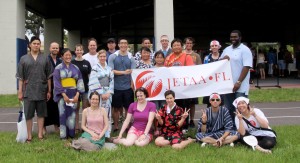
New JETs, JET alumni, and Consul Hayato Nakamura and family at Natsu Matsuri, Tampa, June 2013. (Amanda Bailey)
By Bahia Simons-Lane (Gunma-ken, 2005-07) for JQ magazine. Bahia is the president of the Florida JET Alumni Association.
Summer is a time when those of us who lived in Japan begin to feel nostalgic for the matsuri of our adopted home. In spite of the heat, the summer festivals of Japan were perfect little Japanese moments—just thinking about them brings the taste of yakisoba and takoyaki to your tongue. Sadly, these memories are fleeting.
It’s right around this time of year that the annual Tampa Natsu Matsuri is scheduled, which is why for the past three years I have packed up my car in Miami and embarked on the four hour drive north to help out. Tampa’s Natsu Matsuri provides a chance for newly recruited JETs, JET alumni, friends of JET, and members of the Japanese community in Florida to get together and enjoy the traditional Japanese summer festival experience, while also sharing Japanese culture with Florida residents who may not know much about Japan.
As the brainchild of Florida JETAA’s Tampa regional representative John McGee (Nagano-ken, 2004-05), the festival launched in 2006. Now attracting hundreds of people, Tampa Natsu Matsuri grows annually, with more booths and attendees each year. For this summer’s event, which was held on June 15, I was very excited about our new location at Christ the King Catholic Church, which gives the festival more space to grow, and provides an outdoor area with covering and lights in case of inclement weather. The festival itself features Japanese games for kids, such as kingyo sukui (goldfish scoop), Japanese culture demonstrations, and sales of Japanese food and goods. The okonomiyaki is always a hit, and this year a few food trucks even joined us for the event.
The festival is usually held in June or July. If you’re in Tampa next summer, I hope you’ll come relive your memories of Japanese summers.
To participate in or receive emails about Tampa Natsu Matsui, please email tampa@floridajetaa.org. For John McGee’s June 2012 JQ article about the history of the festival, click here.
JQ Magazine: JETerations — How Alumni Touch New Generations of JETs

Clare Grady and William Collazo representing fifteen years of JET at the Pre-Departure Orientation, Florida, 2012. (Courtesy of William Collazo)
By Bahia Simons-Lane (Gunma-ken, 2005-07) for JQ magazine. Bahia is the president of the Florida JET Alumni Association.
As a high school Japanese teacher in Deerfield Beach, Florida, WIlliam Collazo teaches his students about his time on JET along with his language lessons. Little did he know he would inspire a student to pursue JET years after she left his classroom.
Collazo said that JET was instrumental in deciding to become a Japanese teacher. He has a BA in Asian studies and religious studies, and he also studied Japanese language at Cornell University in New York. After JET, Collazo earned an MA in East Asian studies from Washington University in St. Louis, where he turned his academic interests to studying language pedagogy.
When he applied to the JET Program, he thought he would enjoy the work since he had some high school teaching experience, but mostly he was hoping to enhance his understanding of Japanese culture by living and working there. Instead, his two years on JET from 1997-99 in Hiroshima Prefecture were life-changing. “I didn’t think I would actually become a teacher of Japanese before going,” Collazo explained, “but my experience was so profound that I felt compelled to come home to Florida and share what I had learned in public education.”
His former student Clare Grady graduated from the University of Florida with a BA in Chinese and departed to Northern Gifu on the JET Program last year. It was Collazo’s stories of JET that inspired Grady to apply for the JET Program. It might seem surprising that Grady majored in Chinese and not Japanese, but by the time Grady entered university she already had considerable Japanese capability under her belt due to the Deerfield Beach International Baccalaureate (IB) program. She started studying Japanese when she entered high school, but after completing all the Japanese classes offered at her school she began teaching herself Chinese—earning her the nickname “Kanji Master.”
CLAIR Magazine “JET Plaza” series: Mark Flanigan (Nagasaki)
Each month, current and former JET participants are featured in the “JET Plaza” section of the CLAIR Forum magazine. The July 2013 edition includes an article by JET alumn Mark Flanigan. Posted by Celine Castex (Chiba-ken, 2006-11), currently programme coordinator at CLAIR Tokyo.
***********

“It was a wonderful feeling to be able to walk the same pathways, both physical and metaphorical, that I had first walked a decade before. Much has changed since then, in Japan and in my own life, but I will always remain incredibly thankful to CLAIR and the JET Programme for this “Twice in a Lifetime” chance.”
A native of Pittsburgh, PA, Mark Flanigan (Nagasaki-ken, Hirado-shi, 2000-04) spent four years in Nagasaki Prefecture as an ALT and PA . He applied for JET as part of his long record of work, study and travel abroad, which has given him a deeper understanding of global affairs and insight into different languages, people and cultures. Mark Flanigan currently serves as Program Director with the Japan ICU Foundation (日本国際基督教大学財団) in New York City and is a first-year Resident of International House of New York. He came to New York after two years in Tokyo, where he earned his MA in Peace Studies as a Rotary International Peace Fellow at International Christian University (ICU). Mark has also been a US Army Officer, Presidential Management Fellow (PMF), and CSIS Young Leader.
Twice in a Lifetime
Like the great majority of JET programme participants, I look back with fond recollections on my time in Japan. Unlike most of them, however, I also had a second chance to come back and live in Japan once again. It was an amazing experience, and one which I never planned on, which allowed me to compare my two very different “Japans.” Although I lived in that same country twice, the differences in time, location and purpose made for a very insightful analysis of how both Japan and I had changed in the intervening years.
My first years in Japan were spent as a new ALT who had never been to Asia, much less lived there. While I had some experience teaching English in the U.S. and Mexico, I was not an Asian Studies major and was not at all familiar with the Japanese language. Nonetheless, I grew to love my new life in Hirado, Nagasaki Prefecture. I immersed myself in the community, getting involved in the local karate dojo as well as participating in the various seasonal festivals and extracurricular activities like speech contests, international days and so on. My original plan to stay just one year changed into multiple re-contracting, and I actually ended up spending a total of four years on JET (teaching both in Hirado as a municipal ALT and then as a Teacher-Trainer at the Prefectural Education Center in Omura City.)
Returning to the U.S. after four years in Japan, I became busily focused on other areas and gradually lost touch with my various connections to JET and Nagasaki. I went to graduate school for Public Policy at George Mason University in the Washington, DC area and started serving with the U.S. Government after graduation. My life continued to progress in this new direction, which was successful enough and still internationally focused, but less-connected to Japan with each passing year. I found myself forgetting more and more nihongo and generally feeling like my JET experience, while a wonderful time, was becoming a kind of closed chapter in my life. Read More
JQ Magazine: Kyushu Battenkai – Sharing a Common Love of Japan with the JETAANY Community
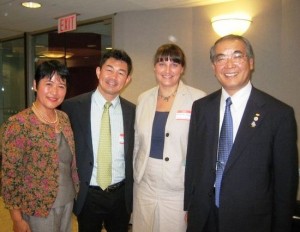
At right, Governor Hodo Nakamura of Nagasaki Prefecture with JET alumna Christy Jones and Kyushu Battenkai members, New York, September 2012. (Mark Flanigan)
By Mark Flanigan (Nagasaki-ken, 2000-04) for JQ magazine. Mark is a program director with The Japan ICU Foundation in New York. Prior to his current position, he was a Rotary Peace Fellow at International Christian University in Tokyo.
The JET Alumni Association of New York is fortunate to benefit from the diversity of such a major metropolitan area like greater NYC. As JET alumni, the members also have the pleasure of joining in with various events and activities with other Japan-related organizations. One of the most active of these organizations over the past few years is the Kyushu Battenkai. JETAANY members have been fortunate to be able to enjoy many get-togethers with them here in the city.
What is Kyushu Battenkai? It’s a very friendly and casual New York civic-based organization that was founded in 1997. Unlike many more formal Japanese organizations, they have no membership fee or official application process. They communicate with their approximately 150 members primarily by email as well as with updates on their website, which was launched in 2007.
The organization was started by a small group of New York-based Japanese people primarily from Nagasaki and Saga Prefectures. They later expanded to include people from all over Kyushu, and have added more activities over the years. They used to celebrate with just the Bonnenkai and Shinnenkai events, but now include about five events throughout the year, including festive spring and summer festival parties and, more recently, exciting jointly planned events with JETAANY.
JET alum Roland Kelts column in Time Magazine on Japan’s Identity Crisis and Right-Wing Rhetoric
********
A thought provoking article by JET alum author and writer Roland Kelts(Osaka-shi, 1998-99) from the current issue of Time Magazine.
The Identity Crisis That Lurks Behind Japan’s Right-Wing Rhetoric
Here’s a quote:
“Japan is a country whose identity has been bowdlerized, hollowed out by a dream of Western dominance that no longer exists. It may make sense to see its recent surge in nationalism as a dumbed-down version of Japanese adolescence. This is a country spun around by its own single-minded pursuit of progress, and it has no idea who it’s supposed to be today.”
Here’s a link to the full article: http://world.time.com/2013/05/31/the-identity-crisis-that-lurks-behind-japans-right-wing-rhetoric/
Posted by Celine Castex (Chiba-ken, 2006-11), currently programme coordinator at CLAIR Tokyo.
The Public Relations Office of the Government of Japan published an article on the JET Programme in their monthly publication that aims to 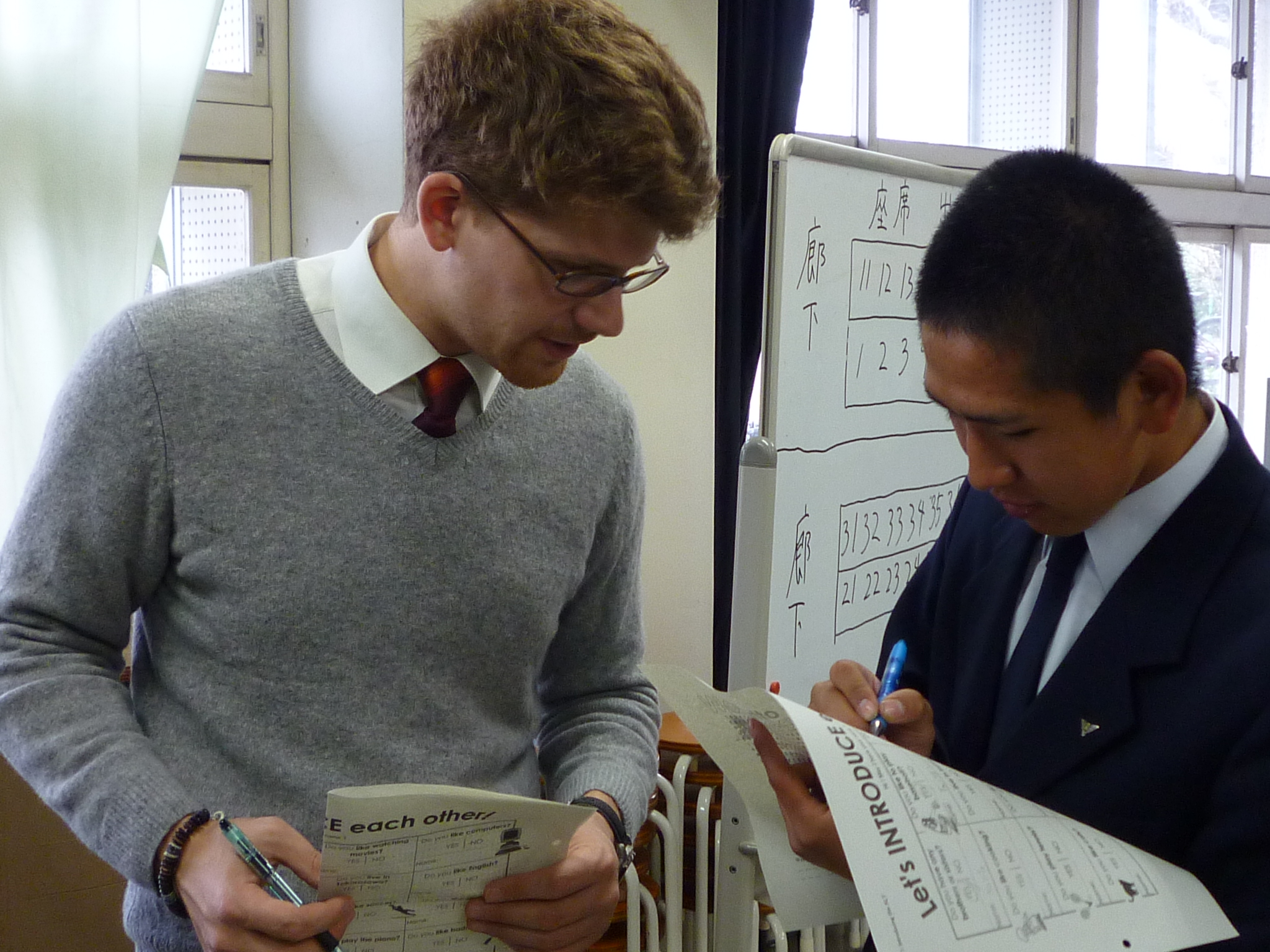 promote a better understanding of Japan in the world. They interviewed Bryan Darr (Saitama-ken, Tokorozawa-shi, 2008-13), current JET participant in Tokorozawa Shogyo High School in Saitama Prefecture. Bryan’s contributions to the JET community include being the Education and Professional Development Coordinator for National AJET in 2011-12, a regular speaker at Saitama Skill Development Conferences and an active member of Peer Support Group (PSG), a listening and referral service administered by AJET.
promote a better understanding of Japan in the world. They interviewed Bryan Darr (Saitama-ken, Tokorozawa-shi, 2008-13), current JET participant in Tokorozawa Shogyo High School in Saitama Prefecture. Bryan’s contributions to the JET community include being the Education and Professional Development Coordinator for National AJET in 2011-12, a regular speaker at Saitama Skill Development Conferences and an active member of Peer Support Group (PSG), a listening and referral service administered by AJET.
Click here to see the article “Young Pioneers of the JET Age.”
JQ Magazine: COBU Gives Sakura Matsuri Season a Beat
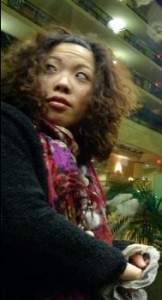
Takae Kawabe, a member of the all-female New York City-based taiko group COBU. (Courtesy of Takae Kawabe)
By Kirsten Phillips (Niigata-ken, 2005-2008) for JQ magazine. Kirsten is a native New Yorker and currently works as a teacher for the New York Board of Education.
Sakura matsuri season is upon us. For JET returnees, this time of year hearkens back to picnics with friends or students. Copious amounts of alcohol under the pink shower of blossoms and maneuvering through crowded lines of vendors celebrating the coming of spring. Sakura season also brings out the finest Japanese talent in New York and no event worth mentioning would be whole without the beating heart of COBU.
You haven’t been following COBU around like a bloodhound? Shame on you. Don’t even know what a COBU is? Double shame on you. Fortunately, oneesan is here to clue you in.
Spearheaded by artist and visionary Yako Miyamoto, COBU is more of a statement in taiko than a collaboration. We are heard. We are seen. We are felt. We are here. A handful of iron women play tirelessly in perfect sync. A little humor, an appropriate smattering of sexy and a metric ton of showmanship make COBU a delight for audiences across the tri-state area.
This year’s Branch Brook Park performance in New Jersey was a staggering hit by COBU, showcasing the talent of their following, or deshi. Upstage, COBU performing members Micro Fukuyama and Haruna Hisada kept time and loudly cheered on the fledgling members as they demonstrated some of COBU’S trademark choreography and pulsing patterns. If you have ever witnessed a COBU show before, it’s easy to become dazzled by the performing members, but this showcase invited audiences to the notion that, hey, they can be a part of this rhythm, too.
JET alum journalist Tom Baker presents Yomiuri Shimbun’s “Japan News” videos
Tom Baker (Chiba-ken, 1989-91) spent many years on the staff of The Daily Yomiuri. On April 1 this year, The Daily Yomiuri became The Japan News. The paper’s website includes a daily video introducing a few sample headlines from each day’s paper, and Tom is one of the presenters. His latest video appears below, and you can see more at the-japan-news.com or The Japan News’ YouTube page.
JQ Magazine: JETAA New York Greets Distinguished Guests
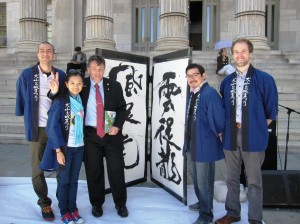
Inuyama City Council Member Anthony Bianchi, center, poses with fellow JET alums at the Japan Friendship Festival, Brooklyn Borough Hall Plaza, May 2013. (Photo courtesy of Ann Chow)
By Ann Chow (Hyogo-ken, 2007-09) for JQ magazine. Ann is a native New Yorker and serves as the Membership Development Chair for the JET Alumni Association of New York.
On April 17, members of the JET Alumni Association of New York (JETAANY) were invited to attend a reception at the Nippon Club for the Governor of Tokyo, Naoki Inose, who was in New York to drum up support for his city’s bid for the 2020 Summer Olympics and Paralympics. Among the guests at the reception included Willie Banks, the three-time track and field Olympian, and world record holder from 1985-95 in Men’s Triple Jump. (Cool trivia: Banks speaks fluent Japanese.)
And on May 3, several JETAANY members, along with employees of CLAIR and the Japanese consulate, were on site to help Inuyama City Council Member Anthony Bianchi (Aichi-ken, 1987-91) and B. Bridges participants at the Japan Friendship Festival at Brooklyn Borough Hall Plaza. The B. Bridges program (short for “Brooklyn Bridge” as well as “Building Bridges” and “Be Bridges”) was created as a cultural exchange program by Bianchi and the administration of Xaverian High School, of which Bianchi is an alumnus.
“The idea for the B. Bridges exchange program was born 10 years ago at an event the Brooklyn Borough President, Marty Markowitz, held for me at Borough Hall after my first election, so it was great to be able to hold this, our Japan Friendship Festival: Inuyama Day at Borough Hall,” Bianchi said.
The program has sent close to 500 people from Brooklyn to Inuyama City and vice versa. This year, 40 participants came from Inuyama City to stay with families of students attending the school. On a beautiful sunny day, JETAANY members were able to help the group out at various booths which showcased tea ceremony, Japanese calligraphy, and traditional Japanese toys and wares.
“The cooperation of the Brooklyn Borough President’s Office, the Japanese Consulate of New York, the Japan Local Government Center, and the JET Alumni Association of New York were crucial to making this event successful,” explained Bianchi.
He added: “I was also proud of our B. Bridges members, as well as our exchange partners at Xaverian High School, who made great use of the opportunity. This, I believe, made the event a great experience for all those in attendance.”
For additional photos from the events, click here and here.


